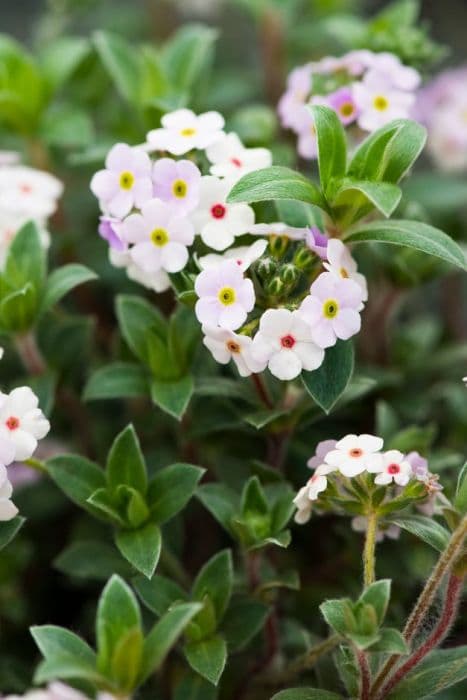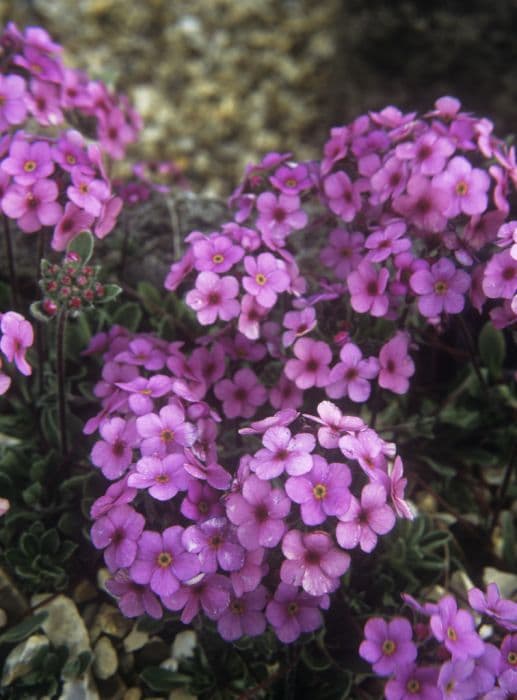Cyclamen Cyclamen 'Concerto Apollo'

ABOUT
Cyclamen 'Concerto Apollo' is a striking plant known for its vibrant and ornate flowers. The blooms are characterized by their swept-back petals, which create an alluring silhouette, somewhat resembling a group of butterflies resting on the heart-shaped, patterned foliage. These petals have a unique coloring, often presenting in shades of pink with a magenta or purple blush towards the base, providing a beautiful contrast with the lighter edges. The center of the flowers usually displays a distinctive darker hue, highlighting the mouth of the bloom. The foliage of the Cyclamen 'Concerto Apollo' adds to its decorative appeal. Each leaf emerges on an individual stem, displaying a rich green color with an attractive silver-marbled variegation. This patterning gives the plant a lush, intricate texture that is pleasing to the eye. The leaves are quite smooth and have a somewhat waxy feel, arranged in a basal rosette that elegantly displays the flowers that rise above them. As an ornamental plant, Cyclamen 'Concerto Apollo' is known for its compact and tidy growth habit. This delightful presentation of blooms and foliage makes it a popular choice for indoor plant enthusiasts and those looking to add a touch of elegance to their garden spaces, with its flowers being a common highlight during the cooler months when they are in full bloom.
About this plant
 Names
NamesSynonyms
Persian Violet, Sowbread
Common names
Cyclamen 'Concerto Apollo'
 Toxicity
ToxicityTo humans
Cyclamen species, including the 'Concerto Apollo', are toxic to humans when ingested. They contain compounds called saponins which can cause symptoms such as nausea, vomiting, and diarrhea. In some cases, the consumption of large quantities could lead to more serious issues like heart rhythm abnormalities, seizures, and even death.
To pets
Cyclamen, including the 'Concerto Apollo' variety, are also toxic to pets such as cats and dogs. If ingested, pets could experience symptoms like vomiting, diarrhea, and salivation. More severe poisoning can lead to symptoms such as heart abnormalities, seizures, and potentially could be fatal. It is particularly important to keep houseplants like cyclamen out of reach from pets to avoid any accidental ingestion.
 Characteristics
CharacteristicsLife cycle
Perennials
Foliage type
Evergreen
Color of leaves
Mixed
Flower color
Varieties
Height
6 inches (15 cm)
Spread
6 inches (15 cm)
Plant type
Bulb
Hardiness zones
9
Native area
Mediterranean
Benefits
 General Benefits
General Benefits- Ornamental Appeal: Adds aesthetic value to gardens and indoor spaces with its vibrant flowers and decorative foliage.
- Seasonal Change: Cyclamen blooms typically in the cool-season, offering color and interest during fall and winter.
- Low Maintenance: Once established, it requires minimal care, making it ideal for busy gardeners or those new to plant care.
- Compact Size: Its small stature allows it to be a perfect fit for indoor potting or small garden spaces.
- Pollinator Friendly: Attracts beneficial insects such as bees, which are important for pollinating other plants.
- Drought Tolerance: Exhibits a degree of drought resistance once mature, which reduces the need for frequent watering.
- Deer Resistance: Typically not favored by deer, which can help prevent damage in gardens where deer are a problem.
 Medical Properties
Medical PropertiesThis plant is not used for medical purposes.
 Air-purifying Qualities
Air-purifying QualitiesThis plant is not specifically known for air purifying qualities.
 Other Uses
Other Uses- Cyclamen petals can be used as a natural dye for fabrics, providing a subtle hue to textiles; extraction of color may vary depending on the mordant used.
- The tubers of cyclamen, especially when dried, can be used as an inert medium for growing orchids and other epiphytes that require well-draining substrates.
- The juice from cyclamen can be used to make invisible ink; writing with the juice appears legible when heated gently.
- Cyclamen's vibrant flowers can be used in potpourri mixes to add color, though they do not impart a strong fragrance.
- Pressed cyclamen flowers can be incorporated into handmade paper, creating an attractive and decorative element for stationery or art projects.
- Can be used as a natural pest deterrent in gardens; the naturally occurring compounds in cyclamen may repel certain insects.
- As a component in a sensory garden, cyclamens can provide a tactile experience with their unique leaf textures.
- Cyclamen flowers are often used in photography as subjects for macro photography practice due to their intricate patterns and vibrant colors.
- The patterned foliage of cyclamen can be used as inspiration for artists in designs and painting, capturing the natural symmetry in their artwork.
- When dried properly, cyclamen flowers can be used in decorative wreaths and floral arrangements, adding color and interest.
Interesting Facts
 Feng Shui
Feng ShuiThe Cyclamen is not used in Feng Shui practice.
 Zodiac Sign Compitability
Zodiac Sign CompitabilityThe Cyclamen is not used in astrology practice.
 Plant Symbolism
Plant Symbolism- Love and Affection: Cyclamen, commonly known as Persian Violet or Sowbread, is often associated with deep love and sincere affection due to its heart-shaped leaves and enchanting flowers.
- Departure and Goodbye: It's sometimes gifted as a symbol of farewell or parting, as it goes dormant after flowering, which can represent a period of separation or a respectful goodbye.
- Sincerity and Trust: Its upright flowers suggest honesty and the trust one may hold in a loving, tight-knit relationship.
- Motherly Love: In the language of flowers, cyclamen is connected to motherly love and care because of its nurturing way of regrowing each year.
 Water
WaterCyclamen prefer to be watered when the soil surface feels dry. Using lukewarm water, water the plant thoroughly until excess water drains out of the bottom, but do not let the plant sit in water. It is essential to avoid watering directly onto the crown of the plant as this can promote rot. During active growth, often in the fall through spring, water once a week with approximately 8 to 16 ounces depending on the size of the pot and the plant's needs. In the summer, when the plant is dormant, water sparingly every two to three weeks, just enough to prevent the tuber from completely drying out.
 Light
LightCyclamens thrive in bright, indirect light, so place your Cyclamen 'Concerto Apollo' near a window with filtered sunlight. Avoid direct sunlight during the hot months, as it can scorch the leaves. A north or east-facing window is typically ideal to provide the moderate light conditions this flowering plant prefers.
 Temperature
TemperatureCyclamen 'Concerto Apollo' should be kept in cool to moderate temperatures, ideally between 60 to 68 degrees Fahrenheit during the day and not below 50 degrees Fahrenheit at night. Avoid exposing the plant to temperatures above 68 degrees Fahrenheit as it may cause the plant to go prematurely dormant. Cyclamen do not tolerate frost and should not be kept in temperatures below freezing.
 Pruning
PruningPruning Cyclamen typically involves removing yellow or dead leaves and spent flowers to encourage new growth and maintain a neat appearance. Prune as needed throughout the growing season, usually during fall to spring. The best time to prune is immediately after flowers fade or when foliage begins to yellow.
 Cleaning
CleaningAs needed
 Soil
SoilFor Cyclamen, a soil mix with equal parts peat, loam, and sharp sand is ideal, promoting excellent drainage. The preferred soil pH level ranges from 6.5 to 7.0.
 Repotting
RepottingCyclamen should typically be repotted every one to two years when it is dormant, usually during the summer months.
 Humidity & Misting
Humidity & MistingCyclamen prefers a moderately humid environment, with ideal humidity levels around 40-50% for optimal growth.
 Suitable locations
Suitable locationsIndoor
Keep cyclamen in bright, indirect light with cool temperatures.
Outdoor
Plant in dappled shade, shelter from intense sun and heat.
Hardiness zone
9-11 USDA
 Life cycle
Life cycleCyclamen 'Concerto Apollo', commonly known as Concerto Apollo cyclamen, begins its life cycle as a tuber, which is a specialized storage organ that remains dormant until conditions are favorable. In late winter to early spring, the tuber breaks dormancy and sprouts heart-shaped leaves along with upright, fragrant flowers that can range in color. After flowering, the cyclamen enters a vegetative stage where it continues to grow and photosynthesize to store energy in the tuber for the next cycle. As temperatures rise in late spring or early summer, the plant enters a period of dormancy, where leaf growth ceases, and the plant retreats to the tuber to conserve resources. The tuber remains dormant through the heat of the summer and possibly into fall. With the onset of cooler and moister conditions in late fall to winter, the cyclamen tuber is stimulated once again to produce new leaves and flowers, thus repeating its yearly cycle.
 Propogation
PropogationPropogation time
Late summer to early fall
Cyclamen 'Concerto Apollo', commonly known just as Cyclamen, is best propagated through seed sowing. The ideal time to propagate by seed is in the fall, as these plants typically go dormant in the summer. To propagate Cyclamen by seed, soak the seeds for 12-24 hours to soften the hard seed coat, enhancing germination rates. After soaking, plant them in a well-draining soil mix, covering them lightly with soil. The soil should be kept moist but not waterlogged, and the container should be placed in a cool, bright spot without direct sunlight. Germination can take several weeks to a few months, so patience is essential with this method. Once seedlings emerge and develop a set of true leaves, they can be carefully transplanted into individual pots.









